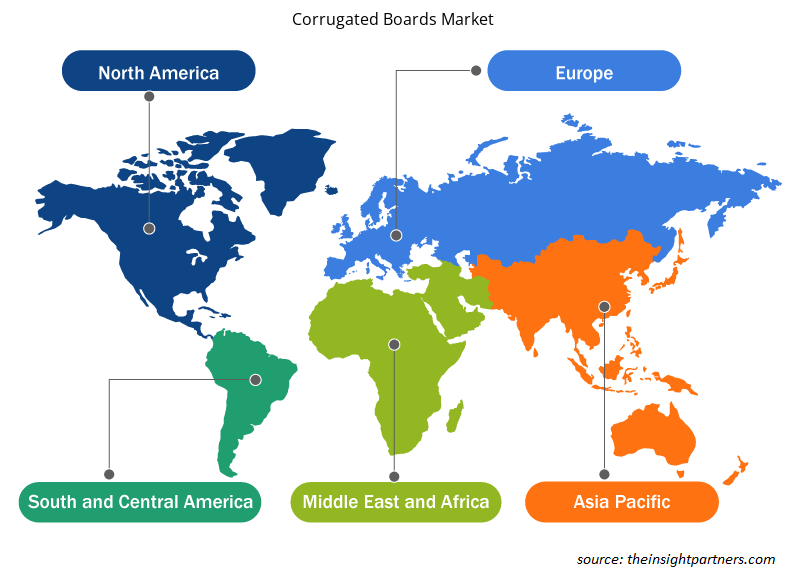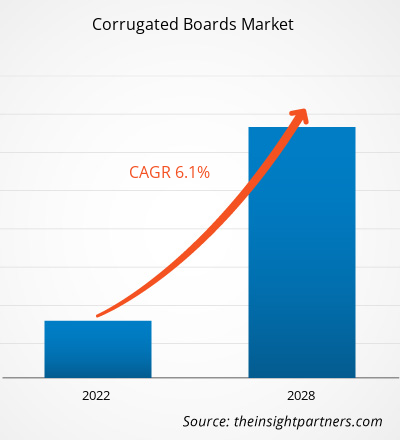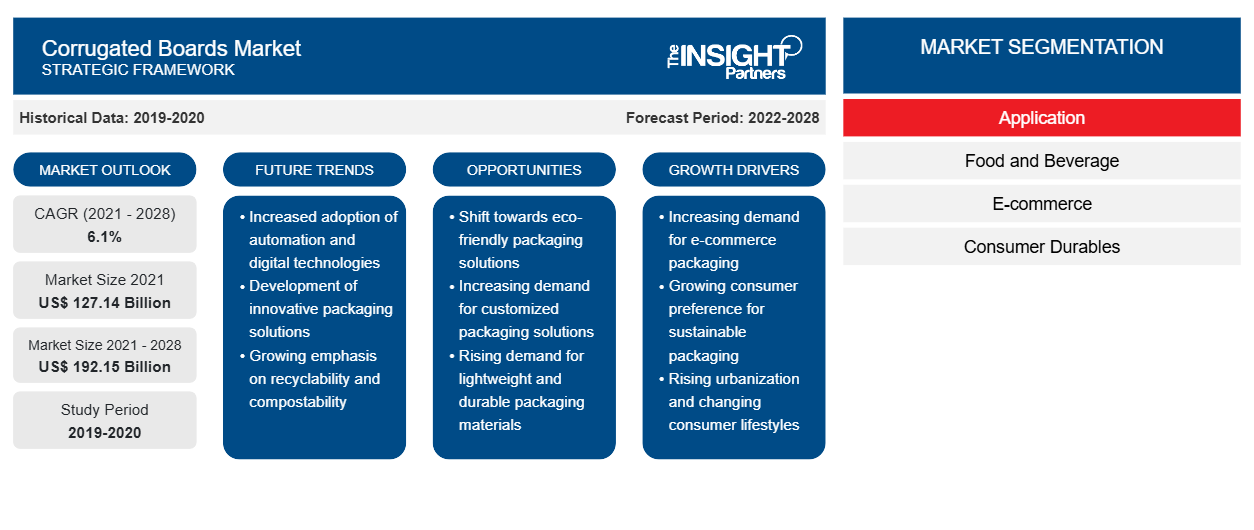[Informe de investigación] El mercado de cartones corrugados se valoró en US$ 127.139,07 millones en 2021 y se proyecta que alcance los US$ 192.153,31 millones en 2028; se espera que crezca a una CAGR del 6,1% entre 2021 y 2028.
El embalaje de cartón ondulado implica el embalaje de diversos productos, como productos alimenticios y bebidas, bienes de consumo duraderos y productos electrónicos y electrodomésticos, en cajas de cartón ondulado para su transporte secundario. El uso de cartón ondulado para embalaje es una técnica de embalaje rentable y adaptable para proteger, conservar y transportar una variedad de artículos. Los cartones ondulados son adecuados para su aplicación en una variedad de industrias, como alimentos y bebidas, bienes de consumo duraderos, productos eléctricos y electrónicos, papel, productos químicos, productos de cuidado personal y del hogar, agricultura, silvicultura, pesca y productos de plástico y caucho.
En 2020, Asia-Pacífico tuvo la mayor participación del mercado mundial de cartón ondulado y se estima que registrará la CAGR más alta del mercado durante el período de pronóstico. En Asia-Pacífico, ha habido un aumento en el consumo de cartón ondulado en varias industrias, como alimentos y bebidas, electrónica y comercio electrónico. El aumento de la conciencia sobre las soluciones de embalaje de cartón ondulado sostenibles y rentables, que se utilizan en el transporte de productos, y varias iniciativas del gobierno para prohibir los envases de plástico en varios países asiáticos impulsarían la demanda de cartón ondulado en la región en los próximos años. Además, un aumento en la conciencia sobre el medio ambiente impulsa la demanda de soluciones de embalaje más ecológicas, lo que está impulsando el crecimiento del mercado de cartón ondulado. Además, el aumento de la demanda de productos electrónicos, repuestos para automóviles, cuidado del hogar y productos de belleza y cuidado personal de los mercados nacionales e internacionales está impulsando la demanda de cajas de cartón ondulado, impulsando así el crecimiento del mercado de cartón ondulado. La industria del comercio electrónico está creciendo a un ritmo rápido en la región. Amazon, uno de los principales minoristas de comercio electrónico, utiliza cajas de cartón corrugado como embalaje principal y recurre al embalaje de plástico para los artículos individuales en Asia-Pacífico. En Tailandia, es probable que las crecientes preocupaciones relacionadas con los residuos de embalaje obliguen al gobierno a establecer regulaciones que inciten a los ciudadanos a adoptar opciones respetuosas con el medio ambiente, como cajas de cartón plegables o de cartón corrugado, como una opción viable para el embalaje, lo que brindaría oportunidades de crecimiento para el mercado de cartón corrugado en la región durante el período de pronóstico.
Personalice este informe según sus necesidades
Obtendrá personalización en cualquier informe, sin cargo, incluidas partes de este informe o análisis a nivel de país, paquete de datos de Excel, así como también grandes ofertas y descuentos para empresas emergentes y universidades.
-
Obtenga las principales tendencias clave del mercado de este informe.Esta muestra GRATUITA incluirá análisis de datos, desde tendencias del mercado hasta estimaciones y pronósticos.
Impacto de la pandemia de COVID-19 en el mercado de cartón ondulado
Muchos sectores, como la industria de productos químicos y materiales, se enfrentaron a desafíos sin precedentes debido a la pandemia de COVID-19. La implementación de los protocolos de seguridad de COVID-19 provocó la escasez de materia prima y mano de obra, el cierre de fábricas y otras dificultades operativas. Por lo tanto, las empresas involucradas en la fabricación de productos de embalaje enfrentaron una contracción en las ventas durante los meses iniciales de la pandemia. El sector del comercio electrónico fue testigo de una demanda significativa de varios productos, como alimentos y bebidas envasados, comestibles, artículos básicos de uso diario, bienes de consumo duraderos, debido al cierre de las tiendas físicas. Con el sector del comercio electrónico en rápido crecimiento, incluso en la pandemia de COVID-19, hubo una demanda significativa de cartones corrugados del sector del comercio electrónico para empaquetar y transferir varios productos. Sin embargo, debido a la escasez de materias primas y el cierre de las unidades de fabricación debido a los cierres prolongados a nivel nacional, hubo una enorme brecha de demanda y oferta, que afectó negativamente al crecimiento del mercado de cartones corrugados. Además, debido a la desaceleración de las operaciones logísticas, la industria del embalaje enfrentó una pérdida significativa.
Las empresas están ganando terreno a medida que los gobiernos de varios países suavizaron las restricciones impuestas anteriormente. Además, la introducción de la vacuna COVID-19 ha aliviado la situación, lo que ha provocado un aumento de las actividades comerciales en todo el mundo. Además, las empresas de logística involucradas en el transporte de bienes esenciales diarios y productos alimenticios y bebidas impulsaron la demanda de cartones corrugados. Por lo tanto, se espera que el mercado mundial de cartones corrugados crezca significativamente en los próximos años. La pandemia de COVID-19 ha impulsado el desarrollo de la industria del comercio electrónico. Ha brindado a los clientes acceso a una amplia gama de productos, como bienes esenciales, productos de conveniencia y productos de seguridad. También ha permitido que las empresas sigan operando a pesar de las limitaciones y restricciones impuestas a diversas actividades industriales y de transporte. La industria del comercio electrónico ha contribuido significativamente a la reactivación de las operaciones logísticas, lo que, a su vez, se espera que impulse el crecimiento del mercado de cartones corrugados en los próximos años.
Perspectivas del mercado
Expansión rápida del comercio minorista en línea
Las plataformas de comercio electrónico han cobrado un impulso significativo en todo el mundo debido a las crecientes inversiones de las empresas en la expansión de su alcance geográfico a través de diversos canales de distribución, junto con el crecimiento del sector industrial. Como resultado, las entregas directas al consumidor han aumentado 20 veces o más que la distribución estándar. Además, los minoristas en línea han experimentado un crecimiento significativo en los últimos años debido a las innovaciones tecnológicas, que han impulsado la demanda de productos de embalaje de cartón ondulado. La pandemia de COVID-19 ha agravado el crecimiento del comercio minorista en línea debido a la orden de distanciamiento social en lugares públicos y las restricciones impuestas para realizar el comercio presencial. Según un artículo publicado por The Rio Times en marzo de 2021, los ingresos generados por los canales de distribución de comercio electrónico aumentaron un 41% en 2020, con más de 194 millones de pedidos realizados por consumidores brasileños en el año. Este es considerado el mayor incremento porcentual registrado en Brasil desde 2007. Según Eurostat, el 70% de la población europea eran compradores electrónicos en 2020, lo que representaba el 60% en 2016. Por lo tanto, el crecimiento de la industria del comercio electrónico impulsa la demanda de soluciones de embalaje avanzadas, como el cartón ondulado, en todo el mundo.
Información sobre aplicaciones
Según la aplicación, el mercado de los cartones corrugados se segmenta en alimentos y bebidas, comercio electrónico, bienes de consumo duraderos, electricidad y electrónica, entre otros. El segmento de alimentos y bebidas representó la mayor participación de mercado en 2020, mientras que se espera que el segmento de comercio electrónico registre la CAGR más alta del mercado durante el período de pronóstico. En la industria de alimentos y bebidas, los cartones corrugados se utilizan con frecuencia en el embalaje y transporte de diversos productos alimenticios. Se utilizan para fabricar cartones y cajas que ofrecen una amortiguación firme durante el transporte y manipulación de diversos artículos, como frutas y verduras frescas, productos cárnicos, huevos y productos de panadería, y son una de las opciones de embalaje más seguras e higiénicas disponibles en el mercado. Los cartones corrugados son limpios e higiénicos ya que se fabrican a altas temperaturas. Los cartones mantienen niveles óptimos de humedad y evitan el crecimiento de bacterias, lo que los hace ideales para el envío de alimentos perecederos. Se espera que este factor impulse la demanda de cartones corrugados de la industria del embalaje de alimentos y bebidas en los próximos años.
Algunos actores que operan en el mercado de cartón corrugado son IRANI PAPEL E EMBALAGEM SA; Pitufit Kappa; Klabin SA; Compañía WestRock; Papel internacional; Arcor; Klingele Papierwerke GmbH & Co. KG; Papeles y Conversiones de México; Mondi; y NIPPON PAPER INDUSTRIES CO., LTD.
Perspectivas regionales del mercado de cartón ondulado
Los analistas de Insight Partners explicaron en detalle las tendencias y los factores regionales que influyen en el mercado de cartón ondulado durante el período de pronóstico. Esta sección también analiza los segmentos y la geografía del mercado de cartón ondulado en América del Norte, Europa, Asia Pacífico, Oriente Medio y África, y América del Sur y Central.

- Obtenga datos regionales específicos para el mercado de cartón ondulado
Alcance del informe de mercado de cartón ondulado
| Atributo del informe | Detalles |
|---|---|
| Tamaño del mercado en 2021 | US$ 127,14 mil millones |
| Tamaño del mercado en 2028 | US$ 192,15 mil millones |
| CAGR global (2021-2028) | 6,1% |
| Datos históricos | 2019-2020 |
| Período de pronóstico | 2022-2028 |
| Segmentos cubiertos |
Por aplicación
|
| Regiones y países cubiertos |
América del norte
|
| Líderes del mercado y perfiles de empresas clave |
|
Densidad de actores del mercado de cartón ondulado: comprensión de su impacto en la dinámica empresarial
El mercado de los cartones corrugados está creciendo rápidamente, impulsado por la creciente demanda de los usuarios finales debido a factores como la evolución de las preferencias de los consumidores, los avances tecnológicos y una mayor conciencia de los beneficios del producto. A medida que aumenta la demanda, las empresas amplían sus ofertas, innovan para satisfacer las necesidades de los consumidores y aprovechan las tendencias emergentes, lo que impulsa aún más el crecimiento del mercado.
La densidad de actores del mercado se refiere a la distribución de las empresas o firmas que operan dentro de un mercado o industria en particular. Indica cuántos competidores (actores del mercado) están presentes en un espacio de mercado determinado en relación con su tamaño o valor total de mercado.
Las principales empresas que operan en el mercado de cartón ondulado son:
- IRANI PAPEL E EMBALAJE SA
- Smurfit Kappa
- Klabin SA
- Compañía WestRock
- Papel internacional
Descargo de responsabilidad : Las empresas enumeradas anteriormente no están clasificadas en ningún orden particular.

- Obtenga una descripción general de los principales actores clave del mercado de cartón ondulado
Informe Destacado
- Tendencias progresivas de la industria en el mercado de cartón ondulado para ayudar a los actores a desarrollar estrategias efectivas a largo plazo
- Estrategias de crecimiento empresarial adoptadas por los mercados desarrollados y en desarrollo
- Análisis cuantitativo del mercado de cartón ondulado de 2019 a 2028
- Estimación de la demanda mundial de cartón ondulado
- Análisis de las cinco fuerzas de Porter para ilustrar la eficacia de los compradores y proveedores que operan en la industria
- Avances recientes para comprender el escenario competitivo del mercado
- Tendencias y perspectivas del mercado, así como factores que impulsan y restringen el crecimiento del mercado de cartón ondulado
- Asistencia en el proceso de toma de decisiones destacando las estrategias de mercado que sustentan el interés comercial, lo que conduce al crecimiento del mercado.
- El tamaño del mercado de cartón ondulado en varios nodos
- Descripción detallada y segmentación del mercado, así como la dinámica de la industria de los cartones ondulados.
- Tamaño del mercado de cartón ondulado en diversas regiones con prometedoras oportunidades de crecimiento
Mercado de cartón ondulado: por aplicación
- Alimentos y bebidas
- Comercio electrónico
- Bienes de consumo duraderos
- Electricidad y electrónica
- Otros
Perfiles de empresas
- IRANI PAPEL E EMBALAJE SA
- Smurfit Kappa
- Klabin SA
- Compañía WestRock
- Papel internacional
- Arcor
- Klingele Papierwerke GmbH & Co. KG
- Papeles y Conversiones de México
- Mundo
- INDUSTRIAS DE PAPEL NIPPON CO., LTD.
- Análisis histórico (2 años), año base, pronóstico (7 años) con CAGR
- Análisis PEST y FODA
- Tamaño del mercado, valor/volumen: global, regional y nacional
- Industria y panorama competitivo
- Conjunto de datos de Excel
Informes recientes
Testimonios
Razón para comprar
- Toma de decisiones informada
- Comprensión de la dinámica del mercado
- Análisis competitivo
- Información sobre clientes
- Pronósticos del mercado
- Mitigación de riesgos
- Planificación estratégica
- Justificación de la inversión
- Identificación de mercados emergentes
- Mejora de las estrategias de marketing
- Impulso de la eficiencia operativa
- Alineación con las tendencias regulatorias























 Obtenga una muestra gratuita para - Mercado de cartón ondulado
Obtenga una muestra gratuita para - Mercado de cartón ondulado